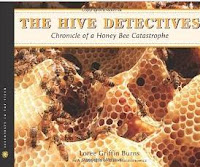Top 10 Kids’ Books on the Environment, 2011
--by Gillian Engberg (from Booklist, March 1, 2011)
From bees to garbage to the water that covers most of the Earth’s surface, the fascinating topics covered in this year’s top youth books about the environment will draw a wide range of young people into the crucial issues.
.

Going Blue: A Teen Guide to Saving Our Oceans, Lakes, Rivers & Wetlands (Cathryn Berger Kaye & Philippe Cousteau). (Gr. 6–10). Cowritten by Jacques Cousteau’s grandson, this broad-reaching call to action introduces basic concepts of global water protection and service learning through stories of international young activists. (ILL)
.
..
.
.
He
 re Comes the Garbage Barge (Jonah Winter; illustrated by Red Nose Studio). (Gr. 1–3). Based on a 1987 incident in which 3,000 tons of trash were shipped from Long Island to North Carolina, Winter’s cautionary tale is illustrated with unique photo images that underscore the story’s message to reduce waste. (ILL)
re Comes the Garbage Barge (Jonah Winter; illustrated by Red Nose Studio). (Gr. 1–3). Based on a 1987 incident in which 3,000 tons of trash were shipped from Long Island to North Carolina, Winter’s cautionary tale is illustrated with unique photo images that underscore the story’s message to reduce waste. (ILL).
..
.
The
 Hive Detectives: Chronicle of a Honey Bee Catastrophe (Loree Griffin Burns; illustrated by Ellen Harasimowicz). (Gr. 6–10). In this timely entry in the Scientists in the Field series, the author of Tracking Trash (2007) spotlights a scientific dream team investigating the possible reasons for diminishing bee colonies. (ILL)
Hive Detectives: Chronicle of a Honey Bee Catastrophe (Loree Griffin Burns; illustrated by Ellen Harasimowicz). (Gr. 6–10). In this timely entry in the Scientists in the Field series, the author of Tracking Trash (2007) spotlights a scientific dream team investigating the possible reasons for diminishing bee colonies. (ILL).
..
 The Hole in the Wall (Lisa Rowe Fraustino). (Gr. 5–8). Set in a community devastated by strip mining, Fraustino’s novel about 11-year-old Sebby and his twin combines fantastical elements with urgent environmental warnings. Winner of the Milkweed Prize for Children’s Literature. (ILL)
The Hole in the Wall (Lisa Rowe Fraustino). (Gr. 5–8). Set in a community devastated by strip mining, Fraustino’s novel about 11-year-old Sebby and his twin combines fantastical elements with urgent environmental warnings. Winner of the Milkweed Prize for Children’s Literature. (ILL).
.
.
..
Kakapo
 Rescue: Saving the World’s Strangest Parrot (Sy Montgomery; illustrated by Nic Bishop). (Gr. 4–7). Winner of the 2011 Sibert Medal, Montgomery and Bishop’s latest Scientists in the Field title offers an exciting account of efforts to save the nearly extinct kakapo parrot on a remote New Zealand island. (ILL)
Rescue: Saving the World’s Strangest Parrot (Sy Montgomery; illustrated by Nic Bishop). (Gr. 4–7). Winner of the 2011 Sibert Medal, Montgomery and Bishop’s latest Scientists in the Field title offers an exciting account of efforts to save the nearly extinct kakapo parrot on a remote New Zealand island. (ILL).
..
 .Leo the Snow Leopard: The Story of an Amazing Rescue (Juliana Hatkoff, et al.). (Gr. 1–3). Continuing the series that began with Owen & Mzee: The True Story of a Remarkable Friendship (2006), a father-and-daughters team of authors offer another moving story of animal conservation. (ILL).
.Leo the Snow Leopard: The Story of an Amazing Rescue (Juliana Hatkoff, et al.). (Gr. 1–3). Continuing the series that began with Owen & Mzee: The True Story of a Remarkable Friendship (2006), a father-and-daughters team of authors offer another moving story of animal conservation. (ILL)...
.

Our Earth: How Kids Are Saving the Planet (Janet Wilson). (Gr. 2–5). Packed with inspiring true-life stories on every spread, this collective biography introduces contemporary kids around the world who have made remarkable efforts to help protect the Earth. (ILL)
.
.
.
..
 Seeds of Change: Planting a Path to Peace (Jen Cullerton Johnson; illustrated by Sonia Lynn Sadler). (Gr. 2–4). Of the many recent picture-book biographies of Kenyan environmentalist Wangari Maathai, this poetic, vibrantly illustrated title offers the most thorough view of the Nobel Peace Prize winner’s youth. (ILL)
Seeds of Change: Planting a Path to Peace (Jen Cullerton Johnson; illustrated by Sonia Lynn Sadler). (Gr. 2–4). Of the many recent picture-book biographies of Kenyan environmentalist Wangari Maathai, this poetic, vibrantly illustrated title offers the most thorough view of the Nobel Peace Prize winner’s youth. (ILL).
.
..
 ..
..Ship Breaker (Paolo Bacigalupi). (Gr. 8–12). Bacigalupi’s YA debut won the 2011 Michael L. Printz Award for its gripping, science-fiction story of young scavengers struggling to survive on a gulf coast devastated by global warming. (YA FIC BACIGALUPI SHIP)
.
.
.
.
. .
 Up We Grow! A Year in the Life of a Small, Local Farm (Deborah Hodge; illustrated by Brian Harris). (Gr. 1–3). With sensory language and interactive questions, this photo-essay about a year on a communal organic farm introduces the picture-book crowd to sustainable agriculture. (ILL)
Up We Grow! A Year in the Life of a Small, Local Farm (Deborah Hodge; illustrated by Brian Harris). (Gr. 1–3). With sensory language and interactive questions, this photo-essay about a year on a communal organic farm introduces the picture-book crowd to sustainable agriculture. (ILL).
.
.
[All books designated as “(ILL)” are currently on order for the Copper Queen Library’s collection and are also available through Interlibrary Loan.]

<< Home